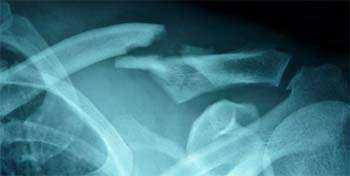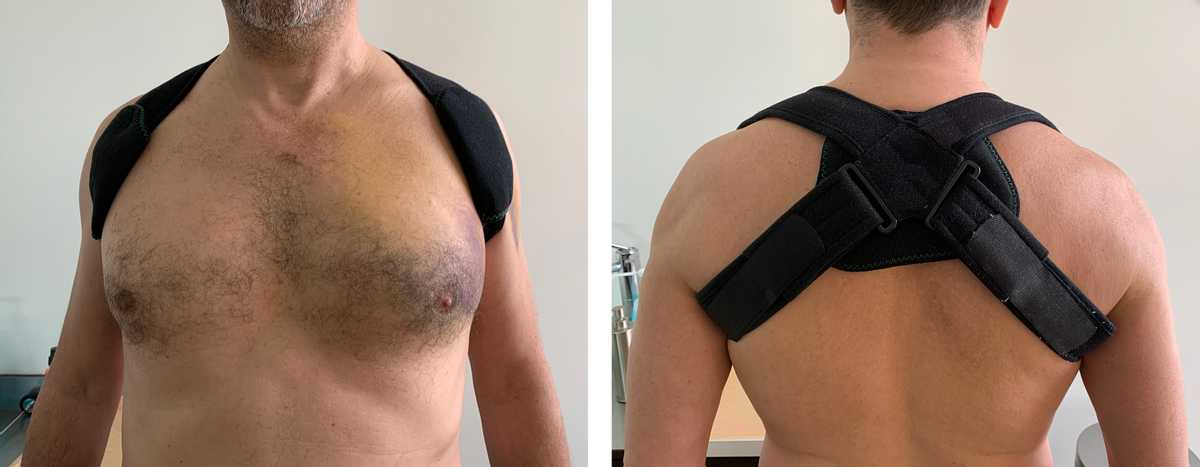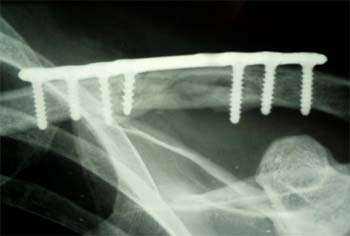Fracture of the clavicle: Diagnosis & treatment
Fractures of the clavicle essentially occur as a result of a fall affecting the shoulder and they are frequent with sports activities such as skiing, cycling, judo, or in street accidents involving pedestrians, bicycles, scooters or motorbikes.
Introduction

Fractures of the clavicle are common and for the most part, benign.
Essentially they occur as a result of a fall affecting the shoulder and they are frequent with sports activities such as skiing, cycling, judo, or in street accidents involving pedestrians, bicycles, scooters or motorbikes.
Treatment is often incorrectly regarded as being solely medical with simple reduction, whereas some of these fractures do require surgical treatment to obtain an optimal functional result.
A bad result with pain and loss of mobility in the shoulder may indeed be due to healing (consolidation) where there is extensive deformation of the clavicle, the absence of healing, or a lesion in the blood vessels and nerves leading to the arm located in the immediate zone.
Diagnosis
Diagnosis is usually simple given the pain, bruising and sometimes deformation which is the result of a trauma or a fall involving the shoulder and which makes using the arm difficult from the beginning.
In general an x-ray is sufficient to make a clear diagnosis, locate the fracture on the clavicule, determine the displacement, the number, size and position of the different fragments, and thus to evaluate the extent of the fracture.
In some cases, a scanner with 3-dimensional reconstruction can be helpful for a better assessment in terms of the position of the fragments, or an echography with doppler when an associated vascular lesion is suspected, and an electromyogram (EMG) may be useful to verify possible damage to the adjacent nerves (brachial plexus).

Medical treatment
Simple immobilisation is the solution which is most often indicated.
This can be realised by means of a sling or using rings with the aim of limiting displacement of the fracture, and should be maintained for 3 to 5 weeks.
Immobilisation is recommended in cases of simple fracture, with moderate displacement without excessive reduction in the length of the clavicle, and where there is no nerve or vascular compression, or fragment edge that could cause possible sub-cutaneous damage.
Pain is generally reduced quite quickly at rest, but can last several weeks when the shoulder is subject to movement. Sports activities may be resumed after a period of 6 weeks to 3 months depending on the type of fracture, on the progress in terms of consolidation observed on the follow-up x-rays, and on the discipline practised.

Surgical treatment
- Anaesthetic: general.
- Hospitalisation: approximately 2 nights
- Immobilisation: Sling 4 to 6 weeks
Even if it is indicated much less frequently than medical treatment, surgical treatment is often neglected because it is not well known and too many patients suffer because their fractures fail to heal, or there is malpositioning during the consolidation process, whereas the latter situations may well be prevented when appropriate treatment is undertaken in the early stages.
Surgery makes it possible to fix the fracture in the correct position, mostly by means of a screw-fixed anatomic plate made to the shape of the clavicle.
It provides immediate anatomic reconstruction, and a rapid reduction in pain.
Surgical treatment is particularly indicated for severely displaced fractures with salient bone fragments under the skin or fragments compressing nerves or vessels in the surrounding zone, or which cause extensive shortening of the clavicle, in serious accidents involving other regional fractures, or in cases where high level sports players want to resume their activities rapidly. A relatively long scar the length of the clavicle is however necessary and it tends to enlarge with time. The plate may be salient under the skin with slim patients, and à priori it must be removed during second intervention.
External fractures of the clavicle constitute a specific type of case, often requiring surgical treatment in cases with displacement, given the risk of non consolidation and persistent functional discomfort if a simple immobilisation system is applied.
Surgical treatment is undertaken using pins, or the positioning of a reinforcing ligament to maintain the fracture in the correct position rather than using a plate; the system is therefore more fragile with a greater risk of early displacement of both the material and the fracture.
In intermediate situations where treatment may be either medical or surgical, the various advantages and disadvantages associated with each option are discussed with the patient in order to determine the solution that is most appropriate to the individual case.
Emergency clavicle fracture:
Not all clavicle fractures require urgent surgery, but in some cases, prompt treatment is preferable to avoid complications or a difficult recovery. When there is significant displacement of bone fragments or a risk of poor healing, early surgical intervention promotes faster recovery and better shoulder function.
For any recent fracture, you can contact Dr. Roure's team so that a solution can be offered to you as soon as possible.
Pseudarthrosis
Pseudarthrosis is an absence of healing following a fracture, and is not uncommon in the clavicle.
It is most frequent in cases where there is an extensive space at the fracture site, multiple fragments, or in cases with insufficient immobilisation.
Surgical treatment is usually indicated as pseudarthrosis is often poorly tolerated by the patient, and requires the positioning of a plate, with a bone graft taken from the iliac bone.
Vicious callus
A vicious callus occurs when the clavicle fracture heals in an incorrect position, i.e. with extensive shortening, the presence of fragments which are damaging to the skin or deeper anatomic elements, or with extensive angulation.
In cases with severe functional discomfort, a surgical solution is indicated, requiring the refracturing of the clavicle and correction of the displacement as normal bone anatomy is achieved with the help of a graft taken from the iliac bone most often fixed in place using a plate.
Risks
- Evolution is long, the patient must be motivated not only for surgery and the immobilisation period, but also for physiotherapy in order to obtain a good result.?
- In spite of good alignment of the fracture after surgery, there remains the possibility of problematic or even incomplete healing, known as pseudarthrosis, and the latter may necessitate a further surgical procedure.
- During surgical treatment, there is the risk of lesion of the nerves and vessels leading to the arm and even of the lung because of their proximity to the clavicle. This type of surgery must therefore be realised by a specialised team.
- Cutaneous necrosis: this is a rare complication but it remains possible, requiring prolonged local treatment, or covering surgery.
- Pain: may persist for several weeks after surgery depending on the individual case.
- Algoneurodystrophy, or retracile capsulitis of the shoulder, impossible to predict, it remains a possibility and causes pain, and stiffening in the shoulder and can also affect the arm.
- Evolution of the condition is often long and difficult, and can last several years, with the side-effect of limited mobility of the shoulder. This phenomenon is also impossible to predict.
- Infection: This is rare but always possible, requiring adapted treatment or further surgery.
- Haematoma: i.e. bruising caused by an effusion of blood, which may necessitate another surgical procedure
- Inflammatory scarring: this can occur depending on the type of skin.
- Loss of sensitivity: around the scar is usual and improves with time.
- Stiffening of the shoulder: this may occur in certain patients and take several months to regress, or may prove persistent.